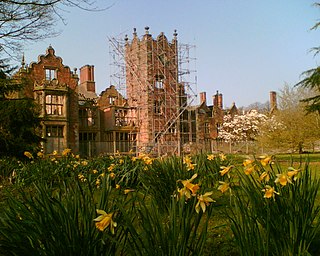Related Research Articles

Oadby and Wigston is a local government district and borough in the English county of Leicestershire. It was formed in 1974, under the Local Government Act 1972, from the merger of the Oadby and Wigston urban districts. The population of the district at the 2011 census was 56,170. The district forms part of the Harborough constituency.

Wigston, or Wigston Magna, is a town in Leicestershire, England, just south of Leicester on the A5199. Wigston had a population of 32,321 in 2011.

Oadby is a small town in Leicestershire, three miles south east of Leicester city centre. The town is famous for Leicester Racecourse, situated on the border between Oadby and Stoneygate, and the University of Leicester Botanical Garden. Oadby had a population of 23,849 in 2011 and like its neighbour Wigston, Oadby is made up of five wards and is one of several satellite towns surrounding Leicester. The Borough of Oadby and Wigston is twinned with Maromme in France, and Norderstedt in Germany.

Baron Lilford, of Lilford in the County of Northampton, is a title in the Peerage of Great Britain. It was created in 1797 for Thomas Powys, who had previously represented Northamptonshire in the House of Commons. His grandson, the third Baron, served as a Lord-in-waiting from 1837 to 1841 in the Whig administration of Lord Melbourne. He was succeeded by his son, the fourth Baron, an ornithologist.
Robert de Beaumont, 2nd Earl of Leicester was Justiciar of England 1155–1168.

Stoughton is a village and civil parish in the Harborough district of Leicestershire. The population at the 2011 census was 351.

Gaulby is a village in Leicestershire, England, 7 miles east of the city of Leicester. According to the 2001 census it had a population of 131,. including King's Norton and increasing to 241 at the 2011 census.
Gartree High School is a coeducational secondary school with academy status. Its age-range designation is 11–16. GCSEs have been taught since 2017 and its first GCSE results published in 2019. The school is situated in Oadby, a town on the south side of Leicester, England.

Thomas Atherton Powys, 3rd Baron Lilford, was a British peer and Whig politician.

Garendon Abbey was a Cistercian abbey located between Shepshed and Loughborough, in Leicestershire, United Kingdom.

Bank Hall is a Jacobean mansion in Bretherton, Lancashire, England. It is a Grade II* listed building and is at the centre of a private estate, surrounded by parkland. The hall was built on the site of an older house in 1608 by the Banastres who were lords of the manor. The hall was extended during the 18th and 19th centuries. Extensions were built for George Anthony Legh Keck in 1832–1833, to the design of the architect George Webster.

Colonel George Anthony Legh-Keck (1774–1860) was a British MP in the Georgian era who owned landed estates in Leicestershire and Lancashire.

Atherton Hall was a country house and estate in Atherton historically a part of Lancashire, England. The hall was built between 1723 and 1742 and demolished in 1824. In 1894 this part of Atherton was incorporated into Leigh. Christopher Saxton's map shows there was a medieval deer park here in the time of Elizabeth I.
Anthony James Keck was an English politician who sat in the House of Commons from 1765 to 1780.

Thomas Powys, 2nd Baron Lilford was a British peer. He was the son of Thomas Powys, 1st Baron Lilford and Mary Mann of Lilford Hall. He succeeded his father as Baron Lilford in 1800. He was educated at Eton College, St John's College, Cambridge and Lincoln's Inn (1794). He married Henrietta Maria Vernon Atherton of Atherton Hall, Leigh on 5 December 1797 at Penwortham, Lancashire and they had twelve children.
Sir Anthony Keck was a British lawyer and politician. He was a member of Parliament between 1691 and 1695, and served as Commissioner of the Great Seal from 1689 to 1690.
Sir Thomas Beaumont of Stourton Grange, Leicestershire was an English Member of Parliament for Leicester.
References
- ↑ "The Domesday Book entry for Stoughton". Domesdayextracts.co.uk. Retrieved 2012-11-19.
- ↑ "Stoughton - The Church of St Mary and All Saints, Stoughton". Leicestershire Villages. 2008-08-26. Retrieved 2012-11-19.
- ↑ "Stoughton - Picture Gallery". Leicestershire Villages. Retrieved 2012-11-19.
- ↑ "Stoughton Parish Plan (extract) - Draft Supplementary Planning Guidance: Village Design and Land Use". Cmispublic.harborough.gov.uk. Retrieved 2012-11-19.
- ↑ "No. 23704". The London Gazette . 8 February 1871. p. 473.
- ↑ Good Stuff IT Services. "Lodge Cottage - Oadby and Wigston - Leicestershire - England". British Listed Buildings. Retrieved 2012-11-19.
- ↑ Good Stuff IT Services. "Grange Cottage - Oadby and Wigston - Leicestershire - England". British Listed Buildings. Retrieved 2012-11-19.
- ↑ Good Stuff IT Services. "South Lodge - Oadby and Wigston - Leicestershire - England". British Listed Buildings. Retrieved 2012-11-19.